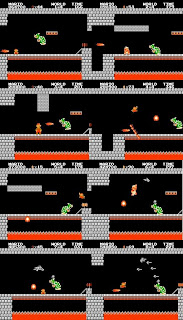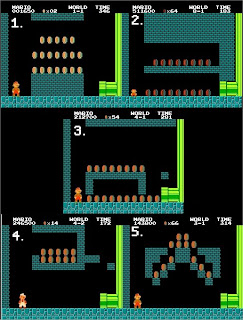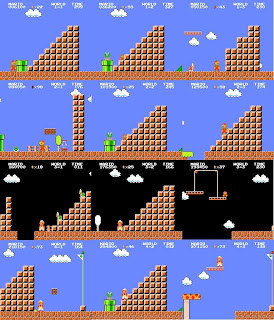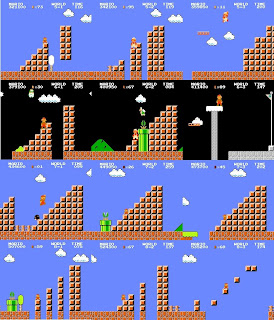Last time in Mario Melodies: Variation part.1, I talked about the different types of variation. Before leaping into open variation, I wanted do a few more examples on strict variation using Super Mario Bros.
Remember, the mechanics of Super Mario Bros. are...
- 0. Idle position (doing nothing)
- 1. Jump (a level.2 mechanic)
- 2. Run, Duck, Slide, Swim, Throw fireball
- 3. Starman powerup, Koopa shell attacks
Minimum difference: Super Mario Bros. is quantified by the unit brick. This means that all the attacks, level elements, enemies, and players are designed to take up space by the brick. Small Mario is about the size of a brick, and ducking Big Mario is a brick high as well. The shortest jump possible clears a distance of two bricks while Mario's largest jump clear a distance of 5 bricks. Little did I know when I first concluded that Super Mario Bros. was quantified by teh brick unit that the elements in the game are set into a grid system that is made up of units that are as large as a single brick. So, in this special case, the game really is quantified by the unit brick.
Things to note...
- Click to enlarge all images
- The world and level are displayed at the top of each example
- Unless explicitly stated, the strategies and possibilities discuss are based on the assumption that the player is small Mario and he/she can't simply take a hit and use the invincibility time to run through dangerous situations.
- For the bonus stages, assume that the player wants to get all the coins and secrets.

- Elements: level = bridge, bricks, axe, and a floating platform. enemy = fire blasts, fire chain, fire balls, Bowser, and hammers
- Overall Trend: refining.
- Method: conceptual variation
- 1-4: This is the first encounter with the boss Bowser, and it is also the simplest. Bowser moves back and forth and mixes things up with fire blasts while the floating platform above him act as training wheels giving the player a large safety area where they don't have to worry about falling on Boswer and getting hurt. This platform also carries the player close to the axe at the right side of the stage. The player is in very little danger on this platform.
- 2-4: The set up for this battle is the same as 1-4 with one notable exception; the low brick "ceiling." This ceiling restricts movement for Small Mario. And when Bowser approaches from the right, it can turn the area into a death trap. Jumping over Bowser in such a situation is very tricky. Fortunately, if you're Big Mario, you can punch a hole in the ceiling, and perform a running jump to get on top of it. Once up in that area, overcoming Bowser is as easy as walking from the ceiling to the floating platform to the axe.
- 3-4: Like the set up in 2-4, the bricks function to restrict possible jump paths for Mario. This time, the bricks don't make a ceiling, but a hanging wall that hangs even lower that the ceiling in 2-4. As Big Mario, this wall can be destroyed transforming the stage into one that functions as 1-4. But because Small Mario can't break bricks, the window for the winning jump that is only possible during the limited time when Bowser backs up to the right side of the stage has been reduced.
- 4-4: This time the floating platform have been removed and the safe window for jumping over Bowser has been reduced. The player will have to coordinate the timing of 4 threats, each with their own unique timer, to successfully overcome this stage; the fire chain, fire balls, fire blast, and Bowser. Fortunately the fire ball comes up in the same place each time.
- 5-4: This stage is like 2-4 but with a fire ball placed in the perfect spot that Mario needs to keep his distance from Bower or to break through the ceiling as Big Mario. Just like my old orchestra director Mr. Lacefield used to say, "familiar" territory can be the most dangerous because you'll want to treat them like you did before. This can make the smallest changes the most deadly.
- 6-4: This is where Bowser starts to get down to business. The hammer projectiles are some of the most dangerous attacks in the game. Unlike the Hammer Bros., Bower throws a lot of them at once. Like the Bowser battle in 1-4, the player is given a chance to become acclimated to this new deadly approach. So, even though the set up has less enemy elements as previous battles, the trend is still refining. Also, it's important to note that Bowser does not shoot his fire blasts in this level. Overcoming the hammers and the fire ball is enough. And just to help the player out, the floating platform is there to increase the safe jumping zone.
- 7-4: This battle is identical to the battle in 6-4, but this time the floating platform is gone. Good luck.
- 8-4: This battle is like the battle in 7-4 except this time, instead of a fire ball mixing things up, Bowser resumes uses his fire blasts. Remember, his fire blasts can come out and level off at one of 3 different heights. Because these blasts move horizontally and they come from Bowser's mouth, the safe area underneath the arc of the flying hammers can easily be compromised. The hammers threaten passage over Bowser, and the fire blasts threaten passage underneath him when he jumps. Also, it's important to note that world 8 has very few opportunity to gain mushroom or fire flower power ups. What you have entering world 8-4 on your first try, is all you'll have to work with. The chances of being Big Mario at this point are slim. This is truly the hardest and ultimate battle between just you and Bowser. No additional platforms, fire balls, or fire chains this time. Winner takes all.

- Elements: level = bricks, coins, secrets bricks.
- Overall Trend: refining.
- Method: linear variation
- Note: These levels are bonus levels because there is no threat to Mario (outside of running out of time) and the player is free to collect coins and powerups without fear of moving the camera too far. Also the exits are clearly marked.
- example 1: The platform is 3 bricks high. After landing on the platform, the coins are easily obtained. This bonus could hardly be simpler. By making the platform 3 bricks high, the player must hold down the jump button to surmount the obstacle. I guess Mario still lives in a world where he has to to work for free things.
- example 2: The jump for the upper area is 4 bricks high. Mario can also get the coins by punching the bricks from underneath. Either way, Mario has to use more advance techniques to get the coins. The last brick before the end contains coins. This is an interesting place to put a secret. Most players would simply run for the pipe after they cleared all the coins. But the player who nabs the upper coins from underneath, and thus using a more advanced, more efficient approach, has a higher chance of discovering this secret.
- example 3: The upper coins in this level are still on a platform that is 4 bricks high. For Small Mario, grabbing all the bricks and the powerup inside the lone brick that hangs over the pipe is an simple task. But for Big Mario, achieving the same level of success requires the use of some fairly advanced techniques. In order to get the coins underneath the structure, Mario must execute a perfect run-slide in the short distance between the left wall and the structure. Once underneath the structure, Big Mario can clear out all the bricks. The by performing a run-slide-ducking-jump, Big Mario can fit himself under the powerup brick and clear the level. This bonus level is an excellent example of a variable difficultly puzzle.
- example 4: Big and Small Mario must master mid air control and the concepts of momentum to get the coins in this stage. Using the run butting in mid air helps. Attempting to jump and pull back using the run button requires Mario to jump up off the top of the screen temporarily. This in itself tests the player's understand of timing due to the game's gravity. When I was a kid, I thought that the coins on this stage couldn't be obtained. Little did I know....
- example 5: In this final underground bonus stage, Big Mario is needed to destruct the structure and make it to the coins on top. To fit up into the spaces after specific bricks are destroyed, players have to use their knowledge of momentum, reversing direction, and the ultimate height of the run-jump. This series of bonus stages provides a great example of adding difficult in a variety of ways that test and require the player to use their knowledge in interesting ways.
- Elements: level = blocks, bricks, floating platforms, secrets bricks, pipes, platforms, pulley platforms, pits enemy = piranha flower, buzzy beetles, koopa, para koopa, bullet bill
- Overall Trend: refining.
- Method: conceptual and linear variation
As an exercise with these end of the level distinct sections, notice how the variation goes back and forth between linear variation, conceptual variation, and static/diminishing/refining trends. It should be obvious that in world 8, the segments are the most difficult. Once you start noticing the variation in a game like Mario, you'll begin to hear the "voice of the developers." More on that later.



